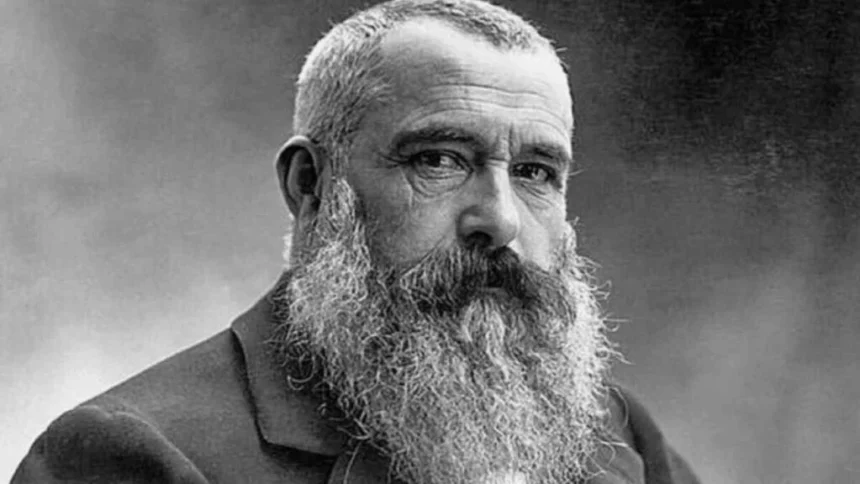Claude Monet, the founder of French Impressionist painting, is celebrated for his profound influence on the art world. His approach to capturing light and natural forms cast a new light on the canvas that became a revolutionary art movement. Monet’s commitment to expressing the variations of reality with colorful and lively brush strokes changed the way people perceive art. In this exploration, we delve into lesser-known aspects of Monet’s work, unraveling elements that continue to fascinate art lovers and critics alike.
Early Influences and the Evolution of a Master
Born in 1840 in Paris, Claude Monet’s upbringing in Le Havre introduced him to his initial artistic endeavors. It was here that he began drawing caricatures and was later introduced to painting landscapes en plein air (outdoors), a technique that would define his career. Monet was heavily influenced by artists like Eugène Boudin and Johan Barthold Jongkind, who mentored him in outdoor painting, emphasizing the importance of natural light and atmosphere in art.
Innovations and Techniques
Monet’s innovation in art was largely in his approach to light and shadow, which he depicted using color and meticulous brushstrokes rather than with harsh lines or contours. This technique, which came to be known as Impressionism, focused on moments rather than details. He often painted the same scene multiple times to capture varying light and weather conditions, as seen in his famous series such as “Haystacks”, “Rouen Cathedral”, and “Water Lilies”. Each series demonstrates Monet’s fascination with how light and color create a sensory impression of a moment in time.
The Artistic Sanctuary of Giverny
In 1883, Monet moved to Giverny, a place that became synonymous with his name. Here, he designed a garden that included a pond with a Japanese bridge, around which he painted some of his most famous paintings, the “Water Lilies” series. These works transcend traditional landscape painting to reflect Monet’s deep contemplation of nature and his surroundings. The gardens at Giverny were both a sanctuary and a continual source of inspiration for Monet, showcasing his extraordinary ability to translate natural landscapes into visions of light and color.
The Beach at Sainte Addresses
One of Monet’s lesser-known yet pivotal works is “The Beach at Sainte Adresse” (1867). This painting, completed during a period of personal turmoil and professional uncertainty, depicts a vibrant scene of leisure activities on a bright summer day. What sets this painting apart is its portrayal of light and Monet’s burgeoning style of capturing momentary effects. The composition shows a blend of tranquility and dynamic activity, making it a stunning example of Monet’s early engagement with outdoor light and his evolving Impressionist techniques.
Claude Monet’s oeuvre extends beyond his famous series of Water Lilies and Rouen Cathedral, encompassing numerous lesser-known gems that provide deeper insight into his artistic evolution and personal vision. One such piece is “The Church at Vétheuil” painted in 1879. During this period, Monet focused on capturing the fleeting effects of light on architecture, a theme evident in this painting. The artwork shows the church under different light conditions, portraying the structure with a luminescence that transforms the solid stone into a vibrant, almost ethereal form. This painting is a testament to Monet’s skill in using color to evoke emotion and atmosphere, marking a pivotal point in his exploration of light.
Another intriguing yet not widely recognized painting is “Jean Monet on His Hobby Horse” from 1872, which depicts Monet’s son Jean riding a toy horse. Unlike his landscape pieces, this painting offers a glimpse into Monet’s personal life and relationships. It’s executed with the same loose brushstrokes and attention to light characteristic of his more famous works but is intimate in its subject matter and scale. The choice of a domestic scene highlights Monet’s interest in capturing everyday moments with emotional depth and artistic significance, showcasing a softer, more personal side to his artistic oeuvre.
Finally, “Ice Floes on the Seine at Bougival” (1867-1868) illustrates a rare winter scene, where Monet captured the icy waters of the Seine, contrasting sharply with the usual flow of the river scenes he often painted. This artwork is particularly notable for its dynamic representation of the frozen elements, where Monet utilized a palette of muted blues and whites to reflect the chill of winter. The brushwork is vigorous, with thick impasto layers that give the ice a tangible texture and solidity. This painting not only emphasizes Monet’s versatility in handling diverse subjects and environments but also underscores his ability to convey the harshness of natural elements through his distinct impressionistic style.
Challenges and Personal Struggles
Despite his eventual fame, Monet’s career was not without its challenges. He struggled with depression, particularly after the death of his first wife, Camille, and faced financial difficulties for many years. It was his unyielding passion for art and his innovative approach to painting that kept him going. Monet’s personal struggles often led him to create works that were initially criticized for their radical departure from traditional techniques, yet these same pieces later became celebrated for their pioneering spirit.
Impact and Legacy
Monet’s impact on art was profound. He not only introduced a new way of seeing but also paved the way for modern art movements such as Post-Impressionism and the Abstract movements. His focus on light and color as the primary subjects of his paintings emphasized the artist’s subjective experience of the scene, which became fundamental in modern art.
Final Years and Lasting Impressions
In his final years, Monet’s eyesight began to deteriorate due to cataracts, yet he continued painting. His later works grew more abstract, characterized by bolder colors and less defined forms, as seen in the later “Water Lilies” paintings. These pieces suggest a shift from the visual to the emotional and metaphorical, which many argue anticipate the abstract art movements of the mid-20th century.
Monet passed away in 1926, leaving behind a legacy that continues to resonate throughout the art world. His works not only exemplify the Impressionist era but also speak to an artist’s enduring dialogue with nature. Monet’s paintings, particularly those created in his beloved Giverny, are celebrated for their exploration of perception and the ephemeral qualities of light and time.
In studying Monet’s body of work, one appreciates the deep personal connection he had with each canvas, making his art timeless. Each piece not only captures a visual reality but also conveys the artist’s intense emotional engagement with the world. This, perhaps, is what makes Monet’s art endlessly intriguing and an enduring study of the beauty of the fleeting moment.



